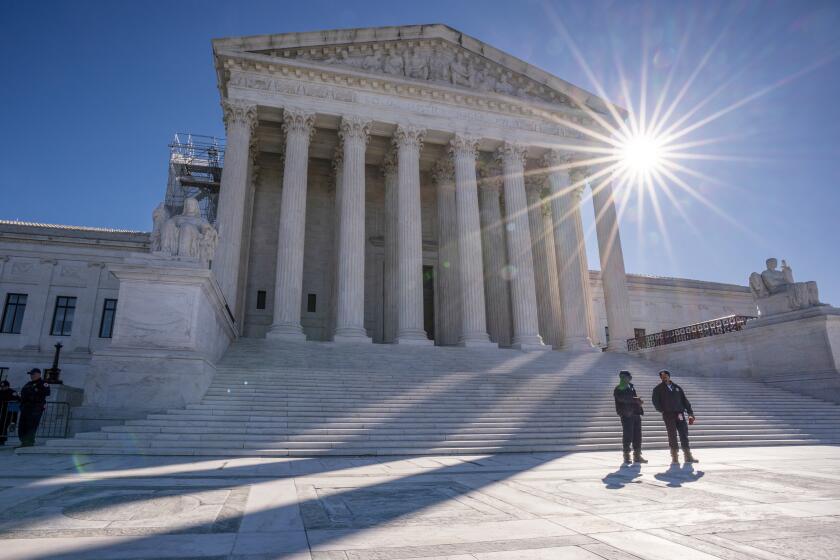A Lesson on Hate Echoes Through Time : Maybe that editor was right all along. Law enforcement may be better equipped than a newspaper to stop violence before it happens.
- Share via
To a young reporter who was covering such sleepy cities as Downey and Bellflower, the story seemed to hold grave, historic importance. Better yet, it promised a glorious splash on Page One.
The Ku Klux Klan was moving on Los Angeles!
It sure looked like they meant business. When they showed up at a Paramount City Council meeting, their scowling leader wore a suit and sunglasses. His scowling cronies wore white hoods and robes. Dozens of sheriff’s deputies were deployed to stand between the Klansmen and a group of Latino activists.
It might have been the only time that TV news swarmed a Paramount council meeting. Film at 11!
This was the early 1980s. The first time the Klan showed up, the Paramount council cleverly failed to muster a quorum. Meeting adjourned. The second time, the council simply gave the Klan leader the usual five minutes per speaker.
It disturbed me when editors buried my stories deep inside the paper. After all, though I had only seen six or seven members, this gaggle of Klansmen claimed to have more than 60 members--and to be growing every day.
The group’s imperial poo-bah invited me and a photographer to attend a meeting and witness their secret rituals. What a story!
There was, he added, just one catch: We can’t reveal the location. We’ll rendezvous somewhere and chauffeur you. And, of course, you’ll have to wear blindfolds.
Hey, no problem!
*
My Klan story, I’ll admit right now, won’t deliver the kind of dramatic climax that the FBI provided last week in the arrests of an alleged network of white supremacists. The arrests, the FBI says, foiled a conspiracy to bomb and shoot worshipers at the First AME Church, and to murder Rodney King, as well as selected African-American and Jewish leaders.
The FBI story was a stunner--at least at first. But upon reflection, it seems even more surprising that such arrests, if not such racial violence, had not already occurred. Hate has such a rich history.
Curiosity prompted me to visit Swinton Avenue in North Hills on Monday, just to see what I would find. I wondered what folks were thinking about the alleged neighborhood Nazis. Christian Gilbert Tony Nadal, 35, and his wife Doris, 42, were arrested on charges of possessing an unregistered submachine gun and a silencer. Chris Nadal is alleged to have sold enough illegal weaponry to arm a pack of terrorists.
The first person I approached happened to be someone who remembered a time and a place when Nazis were all the rage. Eighty-two-year-old Hildy Hilda, out for her daily stroll, spent the first half of her life in Germany, the country of her birth.
She was polite, but not exactly effusive: “Well, Hitler, I think he was a madman. But I didn’t care too much about politics.” She laughed remembering the “fanatics,” mocking how they greeted each other with a floppy-wristed salute, palm out, and a “Heil Hitler.”
A tall, dark man approached us from the opposite direction. He was an immigrant from India, and a naturalized U. S. citizen. He didn’t live in the neighborhood; his job had brought him to this street. He requested anonymity, saying his employer wouldn’t like to see him spouting off in a newspaper.
His own home, he says, is in the Antelope Valley. “I see some rebel flags around town,” he said. “Maybe they’re trying to say: ‘Stay out.’ ”
His response is to sport a replica of the gray caps that were worn by Confederate troops in the Civil War. My friend Mark, who is black, used to do this in high school days--a kind of ironic protest, a calculated reminder of America’s racist roots.
As it happened, I was standing outside a neat yellow ranch home with Old Glory displayed out front. Don Kardashian, a 69-year-old retiree and World War II veteran, puts his flag out everyday. “I just like it,” he said.
Kardashian, a native Californian, said his father immigrated from Russia, having escaped the horrors of the Armenian genocide by Turkish forces. (The Turkish government, of course, disputes that such a genocide occurred.)
His pal Don Wyndom, 63, dropped by to fix his garbage disposal. Wyndom, who happened to be the Neighborhood Watch block captain, said he came to the U. S. from Canada many years ago.
The two Dons railed in salty terms about President Clinton and the decline of values in these United States. To hear Wyndom tell it, it’s amazing how swiftly Clinton and the liberals have ruined things.
Were they surprised to learn that some alleged neo-Nazis lived down the street?
“In this day and age, the way things are going,” Kardashian said, “nothing surprises me anymore.”
*
If you missed my shocking expose about the growing menace of Ku Klux Klan in L. A., that’s because I never wrote it.
I argued, to no avail, that it was our duty to scrutinize these guys before they resorted to violence. My editor was of the opinion that this raggedy little band of miscreants just wanted to use a newspaper story to attract potential recruits.
The editor decreed that we should handle this story with extreme care, writing about them only when public events warranted.
I wasn’t happy about that. But the arrests last Thursday made me reconsider. Maybe that editor was right all along. Law enforcement may be better equipped than a newspaper to stop violence before it happens.
Short of violence itself, fear is the stock in trade for these hatemongers. Some lurk quietly in handsome suburbs but others delight in their image of menace. In our last conversation, my erstwhile Klan contact--after being so cordial--would give me a little taste of that.
Having declined their invitation, I was saying goodby when he interrupted me.
“You live in Seal Beach, don’t you?”
I don’t believe I ever mentioned that.
More to Read
Sign up for Essential California
The most important California stories and recommendations in your inbox every morning.
You may occasionally receive promotional content from the Los Angeles Times.










